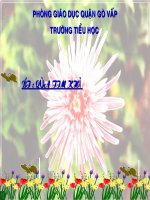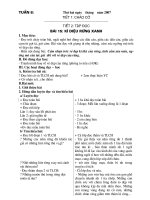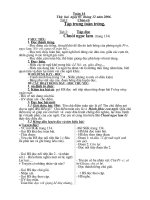Tài liệu Jamie doc
Bạn đang xem bản rút gọn của tài liệu. Xem và tải ngay bản đầy đủ của tài liệu tại đây (1.82 MB, 19 trang )
Brenda Hoddinott
H-14 BEGINNER: FOCUS ON PEOPLE
With a focus on improving your observation skills by
drawing upside-down, this project guides you through
the process of combining lines with simple shading to
draw a realistically proportioned face of a young child.
Skills presented include
• Sketching upside-down to render accurate proportions
• Combining lines to make shapes
• Shading basic values of the face and features with hatching
• Shading the texture of straight hair with feathered, curved hatching lines
The following four sections guide you step-by-step through this project:
SKETCHING PROPORTIONS UPSIDE-DOWN: You sketch the outline of Jamie’s head,
and mark the placement of his facial features proportionately correct – while drawing upside-
down!
ADDING MORE DETAILS TO THE FACIAL FEATURES: A few simple lines and
shapes enhance Jamie’s facial features in preparation for shading.
USING CURVED HATCHING LINES TO DRAW HAIR: Curved hatching lines make
the hair look three-dimensional.
ADDING SHADING TO THE EYES AND FACE: Three different pencils, and simple
hatching lines, give depth and form to the various parts of Jamie’s face.
Suggested supplies include white paper, HB, 2B, and 4B graphite pencils, kneaded and vinyl
erasers, and a pencil sharpener.
This project is recommended for artists from age 12 to adult, as well as home
schooling, academic and recreational fine art educators.
19 PAGES – 31 ILLUSTRATIONS
Published by Hoddinott Fine Art Publishers, Halifax, NS, Canada – Revised 2006
Copyright to all articles, images, text, projects, lessons and exercises within this drawing class belong to Brenda Hoddinott and may
not be reproduced or used for any commercial purposes whatsoever without the written permission of Brenda Hoddinott.
Web sites and
-2 -
SKETCHING PROPORTIONS UPSIDE-DOWN
In this section, your goal is to sketch the outline of Jamie’s head, and then mark the placement of
his facial features proportionately correct – while drawing upside-down! No, you don’t have to
stand on your head! The sketch is upside-down - not you! ☺
Sketching refers to the method used for creating a quick, rough representation or outline of a
planned drawing subject. Proportion is the relationship in size of one component of a drawing to
another or others.
ILLUSTRATION 14-01
1. Use an HB pencil to sketch an egg-shape
with the wider section at the bottom.
To help you draw a more symmetrical
egg-shape, rotate your paper and look at
the shape from different perspectives as
you draw. Symmetry is a balanced
arrangement of lines and shapes on
opposite sides of an often-imaginary
centerline.
Another option, to help guide you through
the process of making both sides
symmetrical is to lightly draw a line of
symmetry down the center of your page
ILLUSTRATION 14-02
2. Lightly sketch a gently curved line
dividing the egg-shape into two sections.
Curved lines are created when a straight
line curves (or bends). Imagine a dot in
the center of this curved horizontal line!
If you drew vertical lines from this dot to
the top and bottom of the egg, both
distances should be approximately the
same.
As for the symmetry, examine the
reflection of your drawing in a mirror to
help locate problem areas. Remember to
keep your lines very light!
Copyright to all articles, images, text, projects, lessons and exercises within this drawing class belong to Brenda Hoddinott and may
not be reproduced or used for any commercial purposes whatsoever without the written permission of Brenda Hoddinott.
Web sites and
-3 -
ILLUSTRATION 14-03
3. Sketch two vertical lines inside
each side of the upper section of
the egg-shape.
Take note of the small triangular
shapes created on either side. Try
and make these shapes the same size.
Don’t think of what the lines
represent! Just focus on the lines
themselves!
ILLUSTRATION 14-04
4. Add two curved lines above the
line that divides the egg-shape
into two sections.
Resist the temptation to turn your
paper around and sneak a peek!
No cheating now!
Familiar objects often look very
unfamiliar when viewed upside
down. Visual information that is
automatically verbally labeled by
your left-brain is no longer
available.
When your left-brain cannot
name and identify the various
parts of your drawing subject, it
eventually gives up trying. This
is where the right brain jumps in
and takes over.
Copyright to all articles, images, text, projects, lessons and exercises within this drawing class belong to Brenda Hoddinott and may
not be reproduced or used for any commercial purposes whatsoever without the written permission of Brenda Hoddinott.
Web sites and
-4 -
ILLUSTRATION 14-05
5. Sketch two upside-down U-shapes
(semicircles) above the two curved
lines.
Even though you are no doubt fully
aware of what you are drawing, try
to send your left brain on a short
vacation.
Rather than naming the parts of this
drawing, allow your right brain to
see only the lines and shapes. Focus
on the lengths of the lines, and the
way they curve to create various
shapes and spaces.
ILLUSTRATION 14-06
6. Add a three part curved line close to
the top of the egg-shape and a slightly
curved line below it.
Refer to the close up in Illustration
14-07 to see these lines more clearly.
ILLUSTRATION 14-07
Copyright to all articles, images, text, projects, lessons and exercises within this drawing class belong to Brenda Hoddinott and may
not be reproduced or used for any commercial purposes whatsoever without the written permission of Brenda Hoddinott.
Web sites and
-5 -
ADDING MORE DETAILS TO THE FACIAL FEATURES
In this section, a few strategically placed lines and shapes, enhance Jamie’s facial features in
preparation for shading.
Before you draw Jamie’s eyes, refresh your memory on the names of the parts of an eye.
ILLUSTRATION 14-08
1. Eyebrows: a cluster of hairs
above the eye
2. Upper Eyelid Crease: a fold in
the skin above the upper eyelid
3. Upper Eyelid: the larger
movable fold of skin above the
eyeball that opens and closes
4. Inside Corner: the small
section of the eye in the inner
corner
5. White of the Eye: the visible
section of the eyeball, that is
light in value, but not white.
6. Lower Eyelid: the smaller movable fold of skin below the eyeball
7. Eyelashes: fine hairs that grow on the edges of the upper and lower eyelids
8. Irises: the big circular shape of the eye that varies in value from very light to very dark
9. Highlights: a tiny bright spot where the light bounces off the shiny surface of the eye
10. Pupils: the dark circle inside the iris
7. Turn your drawing right side up.
8. Sketch another curved line above each eye as the upper eyelid creases.
In the interest of simplicity, this sketch of Jamie’s eye will include only the most important
parts of the eyes, and the eyebrows will be partially hidden under his hair.
ILLUSTRATION 14-09
Copyright to all articles, images, text, projects, lessons and exercises within this drawing class belong to Brenda Hoddinott and may
not be reproduced or used for any commercial purposes whatsoever without the written permission of Brenda Hoddinott.
Web sites and
-6 -
9. Add a shorter curved line below each eye as the edge of the lower eyelid.
ILLUSTRATION 14-10
ILLUSTRATION 14-11
10. Sketch a round shape (the ball of the nose)
above the curved line that indicates the
location of the nose (as in illustration 14-11).
11. Add a smaller round shape on each
side of the ball of the nose (as in
illustration 14-12).
ILLUSTRATION 14-12
12. Add the outline of the upper lip with
a curved line in the center and an
angular line on either side (as in
illustration 14-13).
ILLUSTRATION 14-13
13. Sketch the
lower lip with a
horizontal line
in the middle
and a line on
each side that
angles outward
and upward
toward the
corners of the
mouth.
Copyright to all articles, images, text, projects, lessons and exercises within this drawing class belong to Brenda Hoddinott and may
not be reproduced or used for any commercial purposes whatsoever without the written permission of Brenda Hoddinott.
Web sites and
-7 -
14. Check over your sketch carefully and change anything you’re not happy with.
Look at the reflection of your sketch in a mirror to find any problem sections. If your lines
are drawn lightly, making changes is a piece of cake!
ILLUSTRATION 14-14









